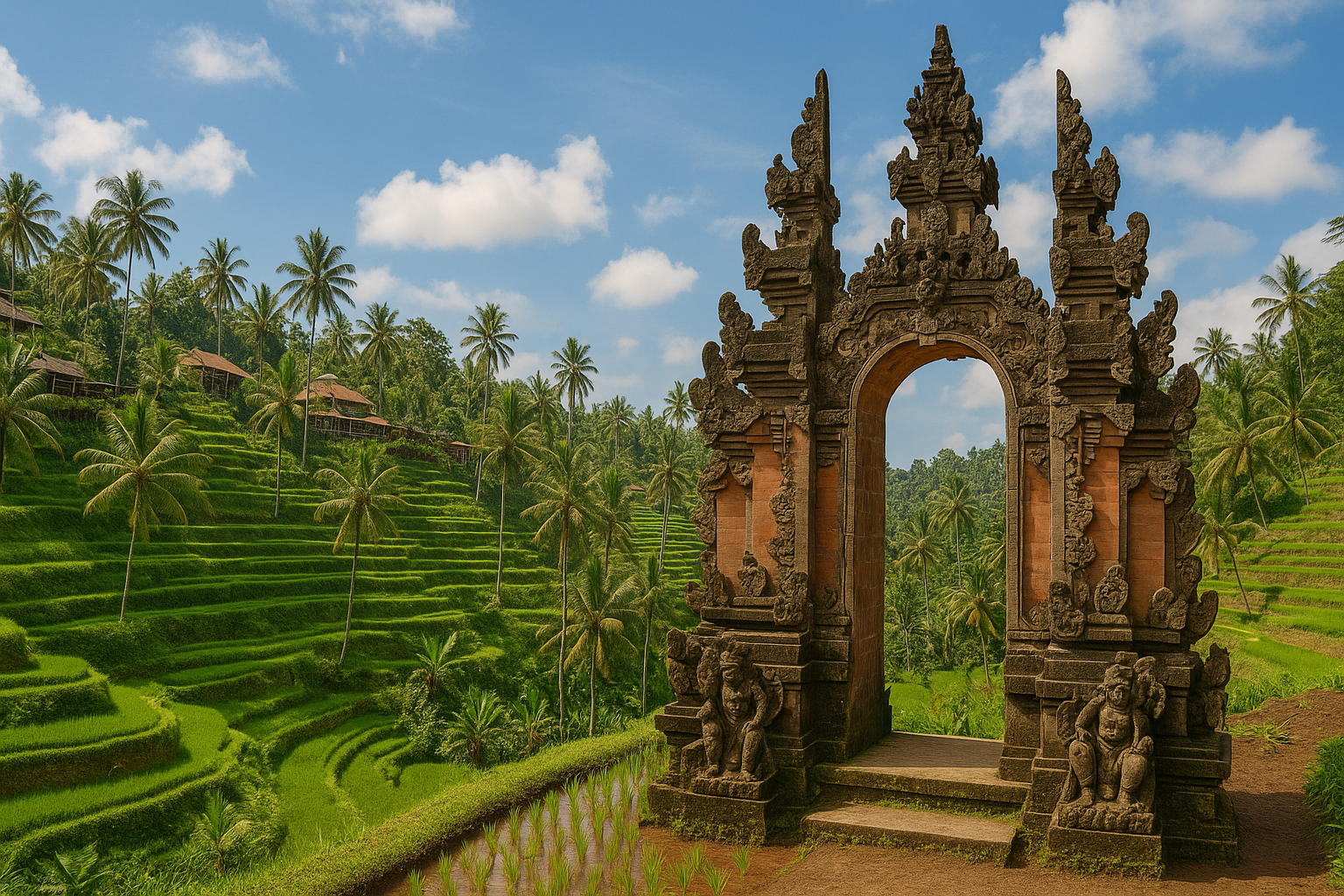- 30 Bali Tourist Attractions That Perfectly Blend Nature and Culture
- Temples and Sacred Sites
- Rice Terraces and Traditional Villages
- Waterfalls and Hidden Canyons
- Mountains and Panoramic Views
- Beaches and Offshore Islands
- Bonus: Cultural & Wildlife Experiences
- Tips for Cultural and Nature Exploration in Bali
- Stay Experience: Villa Hasian Jimbaran
- Frequently Asked Questions (FAQ)
30 Bali Tourist Attractions That Perfectly Blend Nature and Culture
Bali is more than just a tropical getaway—it’s a cultural treasure trove wrapped in stunning landscapes. From sacred temples perched on cliffs to hidden waterfalls deep in the jungle, Bali offers countless destinations where nature and tradition come together beautifully. Here’s a curated list of 30 recommended places in Bali that celebrate both natural wonders and cultural heritage.
Temples and Sacred Sites
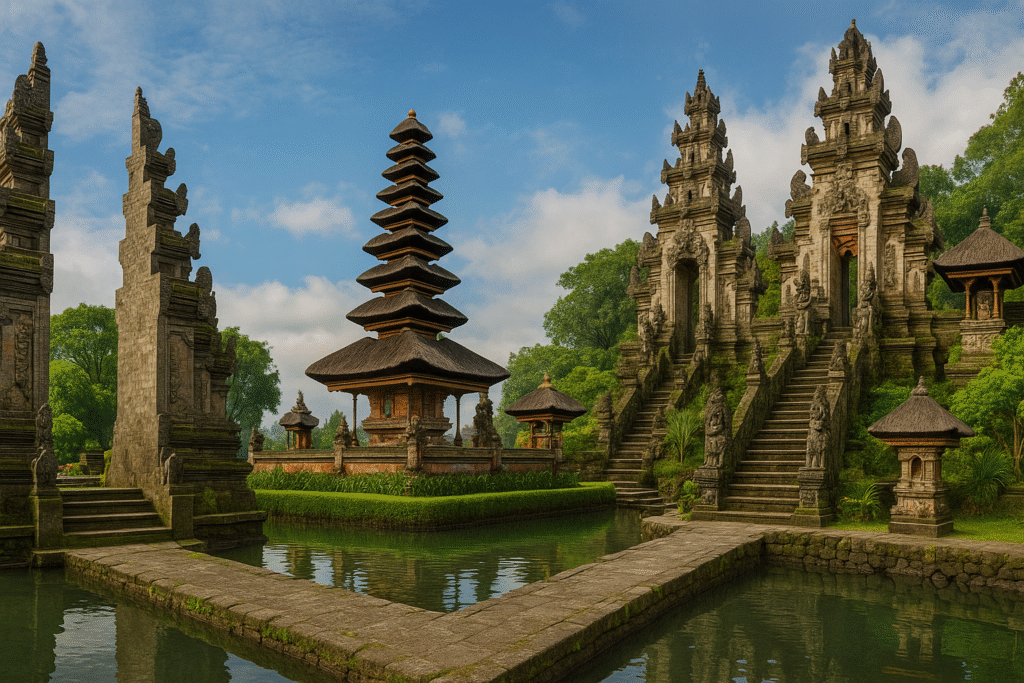
- Tirta Empul (Tampaksiring)
Located in central Bali, Tirta Empul is a famous Hindu water temple in the village of Manukaya, near Tampaksiring. The temple is known for its holy spring water used for purification rituals, where visitors can take part in a spiritual cleansing process in the series of stone-carved pools. - Tanah Lot (Tabanan)
Located on the coast of Beraban village in the Tabanan Regency, Tanah Lot is perhaps Bali’s most iconic sea temple. It sits on a rock formation surrounded by the ocean and is best visited at sunset when its silhouette creates a dramatic backdrop. - Uluwatu Temple (South Kuta)
Situated in Pecatu, South Kuta, this temple is perched on a cliff 70 meters above the Indian Ocean. Uluwatu Temple offers panoramic ocean views and is also famous for its Kecak fire dance performances held every evening. - Besakih Temple (Karangasem)
Located on the slopes of Mount Agung in the Karangasem Regency, Besakih is the largest and holiest Hindu temple complex in Bali. The site includes over 80 temples and plays a central role in Balinese spiritual life. - Goa Gajah (Ubud)
Goa Gajah, or the Elephant Cave, is located in Bedulu Village just outside Ubud. This 9th-century site features a meditation cave, bathing pools, and ancient stone carvings amidst lush surroundings. - Taman Ayun Temple (Mengwi)
Found in Mengwi village, Badung Regency, Taman Ayun is a royal family temple surrounded by a wide moat. It is a beautiful example of traditional Balinese architecture and is recognized as a UNESCO heritage site. - Goa Lawah Temple (Klungkung)
Located in Pesinggahan village, Klungkung, this temple is built around a cave inhabited by thousands of bats. Goa Lawah is an important religious site often included in Balinese spiritual journeys. - Klungkung Palace Ruins
Situated in Semarapura, Klungkung Regency, this historical landmark was once the center of a powerful kingdom. The ruins include decorated pavilions and a museum that showcases artifacts from the Klungkung era. - Trunyan Village
Trunyan is a remote village on the eastern shore of Lake Batur in Kintamani. It is inhabited by the Bali Aga people who practice unique funerary customs by placing the deceased in bamboo cages under a sacred tree.
Rice Terraces and Traditional Villages
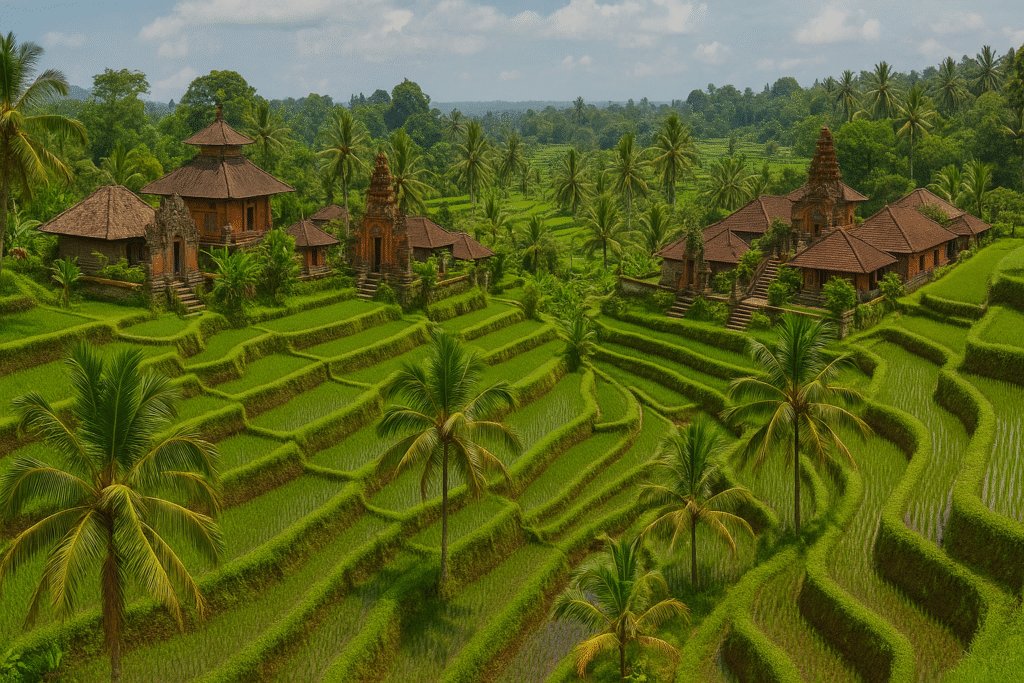
- Tegalalang Rice Terraces (Ubud)
Located north of Ubud in Gianyar Regency, these rice terraces are among Bali’s most photogenic. They showcase the traditional Subak irrigation system and are perfect for leisurely walks or coffee with a view. - Mancingan Terrace
Situated in the village of Mancingan, near Ubud, this terrace offers a peaceful rural landscape. Visitors can enjoy walking paths through rice fields far from the tourist crowds. - Juwuk Manis Subak Walk
Hidden in the heart of Ubud, this trail starts near Jalan Kajeng and leads through tranquil rice fields and irrigation paths, offering a glimpse into traditional Balinese farming. - Sunda Hill (Sidemen)
Located in Sidemen village, Karangasem, Sunda Hill is a scenic sunrise point that overlooks Mount Agung. It offers a combination of natural beauty and traditional rural charm. - Penglipuran Village (Bangli)
This clean and orderly village is located in the highlands of Bangli. Penglipuran is famous for its well-preserved culture and bamboo forest, providing a window into old Balinese ways of life. - Sidemen Village
Situated in East Bali, this valley village in Karangasem is known for its lush terraced landscapes and traditional weaving culture. It’s a serene place for nature lovers and cultural explorers alike.
Waterfalls and Hidden Canyons
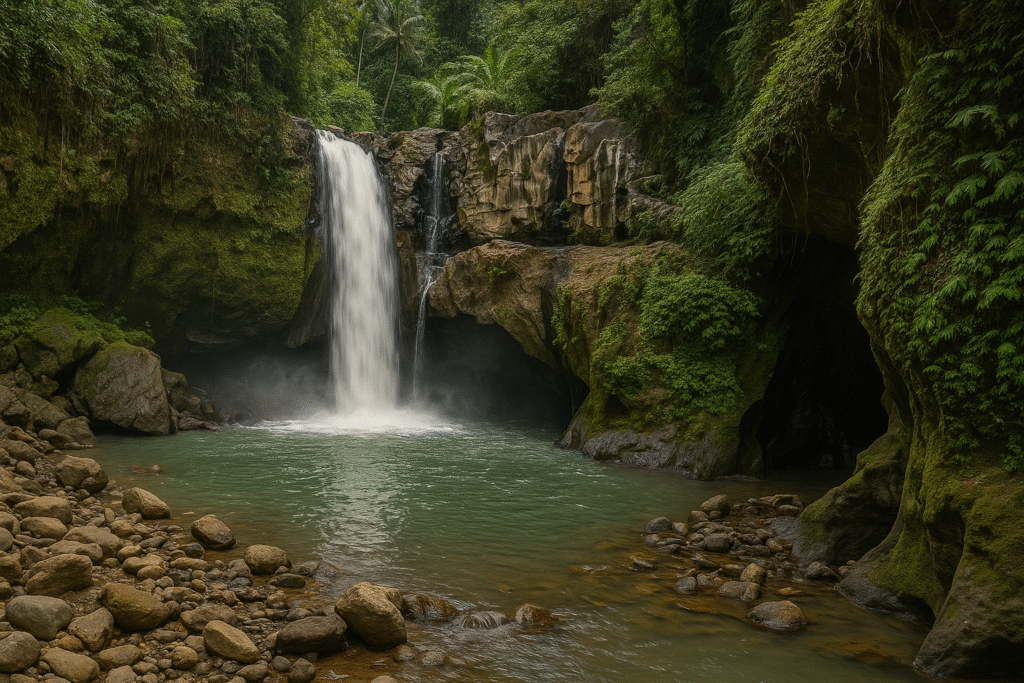
- Tegenungan Waterfall (Gianyar)
Located in Kemenuh village, near Ubud in Gianyar, Tegenungan Waterfall is easily accessible and surrounded by greenery. It is a great place for swimming and photography. - Bayad Waterfall
This peaceful waterfall is located in the Bayad village of Gianyar Regency, near the Tegalalang area. It’s an excellent spot for a quiet escape and scenic jungle views. - Munduk & Sekumpul Waterfalls
These stunning waterfalls are in Buleleng, North Bali. Munduk offers misty, photogenic scenery while Sekumpul is a group of waterfalls best reached via a jungle trek. - Banyu Wana Amertha Waterfall (Sukasada)
Found in Sukasada district of Buleleng, this site features multiple cascades and shaded trekking paths. It remains relatively undiscovered and is perfect for peaceful reflection. - Gembleng Waterfall (Karangasem)
Located in Sidemen, Karangasem, this waterfall is renowned for its natural rock pools that resemble an infinity edge. It also offers panoramic views of the surrounding valley. - Taman Beji Griya (Ubud)
This sacred site is located in Sangeh, just northwest of Ubud. It offers spiritual purification rituals in natural surroundings, including waterfalls and forest trails. - Hidden Canyon Beji Guwang (Sukawati)
Situated in Sukawati, Gianyar Regency, this hidden canyon is carved by the river and features dramatic rock formations. It’s a thrilling spot for adventurous travelers. - Tukad Yeh Hoo & Guyangan Falls
Tukad Yeh Hoo is located in Tabanan, and Guyangan Falls is on Nusa Penida. Both offer secluded natural beauty and refreshing water pools.
Mountains and Panoramic Views
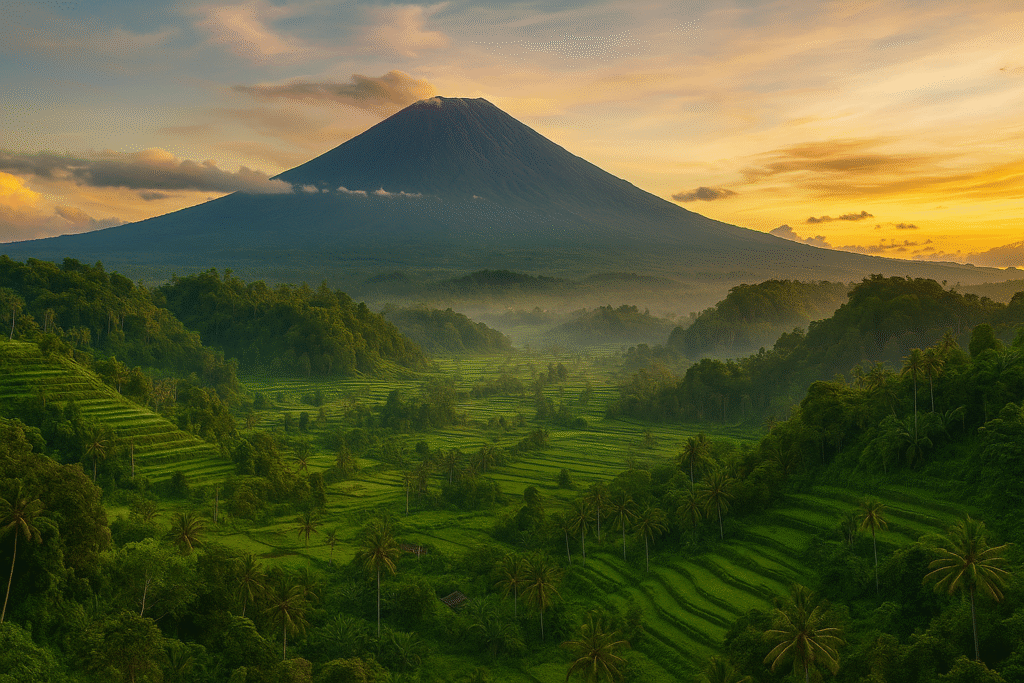
- Mount Batur & Lake Batur
Located in Kintamani, Bangli Regency, Mount Batur is a popular trekking destination. It offers sunrise views and overlooks the crescent-shaped Lake Batur and caldera. - Bukit Jambul Viewpoint
Found in Pesaban village, Karangasem, this viewpoint provides expansive views of terraced rice fields, valleys, and the distant sea. - Labuan Amuk Cliff (Karangasem)
Located near Padangbai in Karangasem, this cliff-top area offers scenic coastal views and is great for photography or quiet contemplation. - Munduk Hidden Hills
This photo-friendly location is near Lake Tamblingan in North Bali. It features bamboo structures and panoramic views of hills and lakes below.
Beaches and Offshore Islands
- Amed Beach
Situated on the northeast coast of Bali in Karangasem, Amed is a peaceful fishing village known for diving, snorkeling, and views of Mount Agung. - Candidasa
Candidasa lies along Bali’s southeastern coast in Karangasem. It is a quiet coastal town perfect for relaxing or diving excursions. - Nusa Lembongan & Nusa Penida
These islands are located southeast of mainland Bali and can be reached by boat from Sanur or Padangbai. They offer dramatic coastlines, marine activities, and iconic landmarks like Kelingking Beach.
Bonus: Cultural & Wildlife Experiences
- Ubud Monkey Forest
Located in central Ubud, this forest is home to hundreds of monkeys and several ancient temples, including Pura Dalem Agung Padangtegal. - Bali Bird Park & Bali Safari Marine Park
The Bird Park is located in Gianyar, near Batubulan, while the Safari Park is in Serongga. Both offer family-friendly wildlife experiences mixed with Balinese performances. - Green Village
Green Village is located near Sibang Gede, not far from Ubud. It is an eco-community known for sustainable bamboo architecture and eco-conscious tours. - Desa Trunyan
Located in Kintamani, Trunyan can be accessed by boat across Lake Batur. It is known for its ancient burial traditions and Bali Aga heritage.
Tips for Cultural and Nature Exploration in Bali
- Best travel time: April to October (dry season).
- What to wear: Dress modestly when visiting temples; sarongs and sashes are often provided.
- Respect rituals: Some sites may be closed for ceremonies—always ask locals or guides.
- Go slow: Don’t try to visit all in one trip. Select 1–2 regions for deeper experiences.
By visiting these destinations, you’ll gain a more profound understanding of what makes Bali truly special: its blend of spirituality, natural beauty, and a culture that continues to thrive.
Stay Experience: Villa Hasian Jimbaran
After a full day exploring Bali’s breathtaking landscapes and cultural gems, why not unwind in comfort at Villa Hasian Jimbaran? Strategically located just minutes from Jimbaran Beach, this tranquil villa offers a luxurious yet homely atmosphere. With private pools, spacious rooms, and lush tropical gardens, it’s an ideal retreat for families, couples, or groups. Whether you’re seeking a peaceful stay near cultural hotspots like Uluwatu Temple or planning to relax after visiting the island’s eastern wonders, Villa Hasian provides the perfect base. Book your stay and discover how easy and comfortable exploring Bali can be.
Frequently Asked Questions (FAQ)
Q: When is the best time to visit Bali for nature and culture experiences?
A: The best time to visit Bali is during the dry season, from April to October, when the weather is sunny and ideal for outdoor activities.
Q: Are these destinations suitable for families with kids?
A: Yes, many of these destinations—like Bali Safari, Ubud Monkey Forest, and Tegalalang—are family-friendly. However, some places like Hidden Canyon or mountain treks may require extra caution.
Q: Do I need a guide to visit temples and nature spots?
A: While not always required, hiring a local guide can enhance your understanding of cultural significance and help you navigate remote or sacred areas respectfully.
Q: What should I wear when visiting temples in Bali?
A: Wear modest clothing that covers shoulders and knees. Most temples provide sarongs and sashes for visitors.
Q: Is it possible to visit all 30 places in one trip?
A: It’s better to focus on specific regions per trip (e.g., Ubud, Karangasem, or North Bali). Attempting all in one visit would be overwhelming.
Q: Can I stay at Villa Hasian Jimbaran while exploring East or North Bali?
A: While possible, it’s recommended to split your stay between Jimbaran and other regions for easier travel time and a more relaxed experience.

